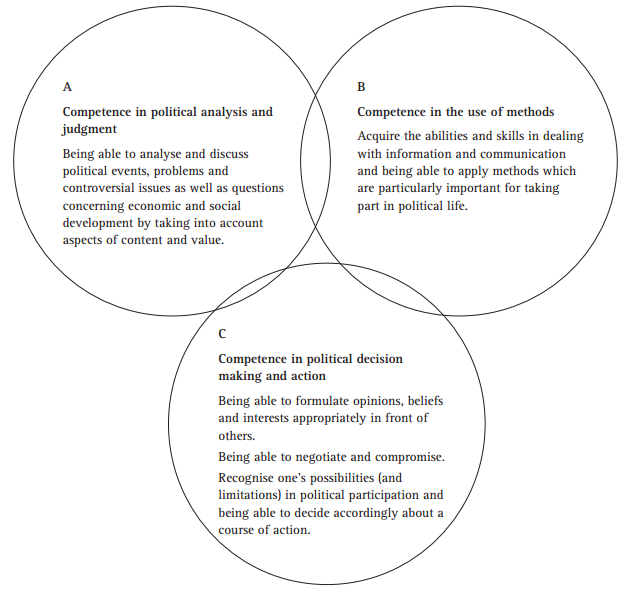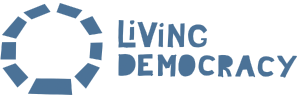2.1 Task
Teachers with a sense of responsibility in their work repeatedly face the problem of justification: what are the reasons for my selection of possible objectives and topics?
Identifying a teaching objective means making the most fundamental of all decisions related to teaching. Objectives should not simply be copied or adapted, nor should they merely be dogmatically imposed. Rather, they should be scrupulously questioned, and their choice should be based on sound reasoning and justification. It is important for a teacher to relate the teaching objectives he or she is considering to the students’ learning conditions and to adjust them accordingly (see Unit 1, Conditions of Teaching and Learning).
As soon as the objectives have become more concrete, aspects of content need to be included. Not until you have decided on the desired level of attainment concerning content matter, that is, the topics to be included, will it be possible for you to define your teaching objectives.
In the planning process, the work on aspects of contents in teaching is both difficult and time-consuming. At first sight, little effort might seem necessary, as the curriculum sets clear guidelines and some teaching media offer detailed suggestions. The main task, however, is left to you, the teacher: you must be well informed on the whole field of knowledge that you wish to teach, you must structure it, acquire a comprehensive understanding of it, analyse it thoroughly, evaluate it critically, make a deliberate choice of topics and objectives for teaching, reflect your decision in a range of wider contexts, check on your selection of topics to identify their educational value, etc. This task is of crucial importance, as the number of possible teaching topics is endless, while the disposable time for planning and teaching is limited.
The following key questions and follow-up questions for your self-control are intended to guide and assist you in this complex task of selecting and preparing topics for teaching. We suggest you co-operate with other teachers, and perhaps also with the students.
2.2 Key questions
For setting objectives:
- What objectives do I wish to achieve?
- What competences will be most important at the end of the unit?
- What reasons do I give for the selection of these objectives?
- What priority do I give to my objectives (primary and secondary objectives)?
- What objectives are important now – for the class as a whole, for individual students, male and/ or female?
- Have I ensured that the objectives that I have selected serve the main interests and needs of my students? Do my lessons really respond to what my students are preoccupied with?
- Is it possible for the students to participate in the definition or selection of the learning objectives?
- How much time (lessons and weeks) has been assigned to achieving the objectives?
- What objectives should be achieved by all the students within the disposable teaching time (general standard of attainment)?
- Are specific levels of attainment to be defined for individual students (education according to individual ability)?
- Have I enabled the students to move forward from knowledge to action, that is, can they confidently apply the knowledge they have acquired?
- What do I focus on in my teaching – cognitive, personal or social competence?
- Have I got a clear idea of the short- and long-term objectives which are of primary importance for my class, for learning groups, for individual male and female students?
- Have I clearly and explicitly stated the objectives?
For selecting topics and materials:
- Which topic have I chosen?
- What are the reasons for my choice?
- What is the structure of my topic?
- Does my choice of topic comply with the syllabus?
- Which aspects of my topic are interesting for my students?
- In what way is learning in school linked with learning out of school?
- Is there a connection between the topic and real life and the students’ environment?
- Do I have a general understanding of the whole subject matter which enables me to select a specific topic? How can I become better informed? Do I need to carry out any studies or experiments before treating the subject in class?
- What teaching materials are available for the specific aspects of the topic?
- Will there be a chance for the students, both boys and girls, to draw on their personal experience, knowledge and skills in the lessons (for example, children with a different cultural or linguistic background)?
- Will the topic be equally suitable for the specific needs of the two sexes?
- Does the selected topic interest me?
2 - Work file 1: Students’ competences for EDC/HRE
Three areas of competence for living and learning democracy and human rights education
The aim of Education for Democratic Citizenship is to support the development of competences in three areas, which, however, are always strongly interconnected and therefore should not be treated separately.

Competence in political analysis and judgment
The aim is to develop the competence to analyse political events, problems and controversial issues and be able to explain the reasons for one’s personal judgment. School can contribute to this process by supporting students to use structured analysis to attain a more sophisticated understanding of matters.
In order to be able to do this, the following skills are necessary:
- recognising the importance of political decisions for one’s own life;
- recognising and judging the consequences of political decisions;
- recognising and presenting one’s personal point of view and the point of view of others;
- recognising and understanding the three dimensions of politics:
a) the institutional,
b) the content-bound,
c) the process-oriented dimension;
- analysing and assessing the different phases of political processes at micro-level (for example, school life), meso-level (for example, community) and macro-level (national and international politics);
- presenting facts, problems and decisions with the help of analytical categories, identifying the main aspects and relating them to the fundamental values of human rights and democratic systems;
- identifying the social, legal, economic, ecological and international conditions, interests and developments in the discussion about current controversial issues;
- recognising the way politics are presented by the media.
Competence in the use of methods
In order to be able to take part in the various political processes not only basic knowledge about political contents, structures and processes are needed but also general competences which are acquired in other subjects (such as communication, co-operation, dealing with information, figures and statistics). Special abilities and skills such as being able to argue for or against an issue, which are particularly important in taking part in political events, must be trained and promoted in Education for Democratic Citizenship. The aim is to use these skills in methods which are widespread in the political discourse (discussions, debates).
In order to be able to do this, the following skills are necessary:
- being able to find, select, process and present autonomously information given by the mass media and/or new media in a critical and focused manner (collect, organise, evaluate statistics, maps, diagrams, charts, caricatures);
- using the media with a critical eye and being able to develop one’s own media products;
- applying empirical methods in a basic way (for example, survey and interview techniques).
Competence in political decision making and action
The aim is to acquire the competences to appear and act in a confident and adequate manner in the political context and in public.
In order to be able to do this, the following skills are necessary:
- being able to voice one’s political opinion in an adequate and self-confident way and to master different forms of dialogue;
- taking part in public life and being able to act politically (oral communication skills such as explaining one’s point of view, discussing, debating, leading or moderating a discussion; written presentation and visualisation techniques for posters, wall newspaper, minutes of a meeting, letters to the editor, etc.);
- recognising one’s own possibilities to exert political influence, forming a team and working together;
- asserting oneself, but also being able to compromise;
- recognising anti-democratic thoughts and tendencies and being able to respond to them adequately;
- being able to behave naturally in a intercultural context.
2 - Work file 2: Two categories of materials in EDC/HRE
Teaching and learning without materials of some kind is impossible, as materials are the media that provide the subject matter, the topics, the information and data. Students develop their competences by activities, which means they “do something” with an object. What first comes to mind is perhaps the school textbook or a handout, and indeed they are important in EDC/HRE.
Two categories of materials in EDC/HRE
However, the specific profile of EDC/HRE is reflected by the wider concept of materials and media. The school textbook and the handout are examples of printed media. In interactive constructivist learning, a different category of materials is created by teachers and students. They are authentic, as they are first-hand materials, produced on the spot, in a particular situation, for the people present there and then. In EDC/HRE, therefore, teachers and students are not only users of materials, but also producers. Volumes II to VI of this EDC/HRE edition give many examples for this category of materials, very often created by students in settings of task-based learning or in projects, and the unit and lesson descriptions explore their rich learning potentials for the students.
A matrix of learning requirements and materials
The following matrix links some typical examples for these two categories of materials – delivered by media, and produced in the processes of interaction involving teachers and students – to different aspects of competence development in EDC. We do not recommend any kind of bias towards one type of material, but rather an integrated approach. However, teaching through democracy and human rights requires teachers to take the products created by students seriously.
| Aspects of competence development | Materials transmitted through media | Materials produced in processes of learning | |
| Materials produced by teachers | Materials produced by students | ||
| Students’ previous development | (Such media and materials exist, of course – for example, children’s books or films – but they are beyond the teacher’s scope of perception) | Preconcepts, previous experience and socialisation processes in the family or with peers, previously acquired information in and outside school | |
| Defining a topic, setting the agenda for a lesson or topic | Brainstorming and discussion inputs | ||
| Information |
Current news reports (printed media, TV, DVD, Internet) School textbook |
Lecture Provision of basic materials (such as flipcharts, markers, coloured paper) |
Student inputs (such as deconstruction of messages transmitted through media, summaries, follow-up homework, presentations, arguments in discussions and debates, comments, questions) |
| Analysis and judgment | Issues and controversies in politics and science (handout, school textbook) |
Instruction on key concepts Criticism demanding deconstruction |
|
| Skills training | Handout (training instructions) | Demonstration and coaching | Feedback |
| Participation and action |
Chairing of sessions |
Experience Questions, comments, insights, interests |
|
| Assessment and evaluation |
Test sheets Questionnaires Portfolios |
Observation |
Self-assessment Feedback Expression of learning needs |
2 - Work file 3: Selecting and using materials in EDC/HRE
Selection of materials transmitted through media
The wider concept of materials implies that both teachers and students select materials. Students do so in their processes of constructivist learning. Here, we focus on the teacher’s role in selecting materials that are to be used in EDC/HRE classes.
Criteria for selecting materials produced by media
- Reliability: are the author, source, date of production, etc., clearly identifiable? Have the text, data, etc., been taken from the original version, and can the students (at secondary level) see if alterations have been made?
- Suitability: does the material meet the student’s level of understanding and competence development, including their experience in deconstructing messages transmitted by media? The materials should be neither too easy nor too difficult; they should demand an effort that improves the students’ skills and adds to knowledge, understanding, and power of judgment.
- Relevance: does the material meet the students’ interests? Does it address a topic or issue that the students regard as important? Can they link the contents to their preconcepts or experience?
- Principle of non-indoctrination or pluralism of perspectives: do the materials show different perspectives? Do they avoid the trap of indoctrinating students – in whatever direction of thinking, judgment or interests (see the file on the professional ethics of EDC/HRE teachers in this volume)?
Handling materials produced by students
Written materials, images, etc: the teacher can study these before or after lessons and decide what steps to take.
Spoken student inputs set considerably more difficult tasks for the teacher, as she/he must react spontaneously and often improvise. See the file on chairing plenary discussions in this volume.


 You are reading Volume I
You are reading Volume I 
